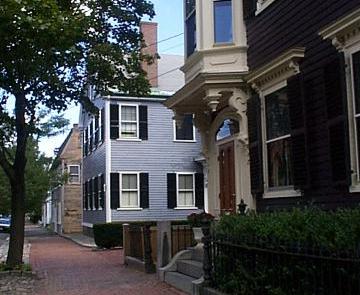Massachusetts
Studies Project
Local History Teaching Tools:
** Buildings and Neighborhoods**
 Introduction:
A neighborhood is a community of houses, streets and landscape that has
a unique character and is part of a larger community. It is a good size
for a study of community functions, for developing a self-guiding trail,
or for a study of architectural styles. This study also encourages a student
to look closely at his or her own neighborhood and become involved in
new ways. Few students take the time to notice the individual structures
in their neighborhoods or to even wonder what they might have been before.
Slowing students down to take a longer look at the community in which
they live can provide them with tangible context for larger historical
themes.
Introduction:
A neighborhood is a community of houses, streets and landscape that has
a unique character and is part of a larger community. It is a good size
for a study of community functions, for developing a self-guiding trail,
or for a study of architectural styles. This study also encourages a student
to look closely at his or her own neighborhood and become involved in
new ways. Few students take the time to notice the individual structures
in their neighborhoods or to even wonder what they might have been before.
Slowing students down to take a longer look at the community in which
they live can provide them with tangible context for larger historical
themes.
For example, when teaching industrialization, the immediate reaction is to take students to the Lowell National Historic Park and Tsongas Industrial History Center, each of which provides superb models for learning and teaching. At the same time, many of the smaller towns in which students live were built on the Lowell model and provide historical context within the familiar. When students begin to see the patterns of, for example, land use in relation to residences vs. industry, owners vs. workers, environmental impact in their own towns, they are better able to see them in whatever industrial towns they may encounter in the future.
General Teaching Tips: In older cities in particular, many of the buildings that remain are those of wealthier individuals who used to live in the community. It is easy to assume from that physical evidence that everyone lived the way that the individuals who peopled those houses did. Likely, very few did. When presented with a historic neighborhood or building, it is essential to ask the students to figure out what else would have existed. Have all the buildings of workers been torn down? What have they been replaced with? Why do those buildings that exist still remain?
Basic Questions
- What makes a neighborhood? Define the neighborhood you are studying: its boundaries, location on a map, numbers of houses, streets.
- What is typical about this neighborhood? Unusual?
- What are the types of land use in your neighborhood? Residential Houses? Business/Stores? Industry? Open Space?
- How do neighbors travel to work? What kinds of transportation are available?
- What is the oldest house date? Are any houses on the National Register? Newest?
- What is the origin of neighborhood street names? (How would you find out? Town or city hall? Neighbors? Library research?
- What role has this neighborhood played in the larger community?
- What issues are of concern to the neighborhood now?
From the National Register of Historic Places, Teaching with Historic Places Template:
1. OVERVIEW: What do you see? What is your general description of the place and its setting?
2. DETAILS: Look closely and identify specific details about location, size, shape, design, arrangement, setting, and other characteristics.
3. IMPRESSIONS: What do your observations suggest about the place's age, purpose, function, and evolution?
4. BIG PICTURE: What do you think the place suggests about people, events, or ways of life from the past?
5. EVIDENCE: Look at your conclusions for Questions 3 and 4. How do you know? What specific clues did the place itself contribute? How influential were previous knowledge or assumptions?
6. QUESTIONS & ANSWERS: What questions did the physical evidence raise for you? What information is missing? What else would you like to know? What types of evidence might answer those questions and test your hypotheses? Where would you find that information?
Critical Thinking Questions
- In neighborhoods that housed the wealthier segments of the population, who are the people you donít see? Who were the people who made life comfortable for residents who lived in those areas? Where did they live? Is there any record left of their contributions to the quality of life in that area?
- Interview members of the community to determine past neighborhood concerns and how the neighborhood has changed.
- Develop a walking tour of the neighborhood as a tourist brochure. Why would anyone not living there want to take the tour?
- Do an inventory of house styles in the neighborhood. Research changing styles.
- Compare the built and natural environments of your neighborhood (percent of each, quality and character and how they relate to each other.
- Students can make a display showing old and new pictures of their neighborhood. Exhibit class pictures from different neighborhoods and tie this in with map studies of the neighborhoods
Resources and Web sites
Teaching with Historic Places: Guiding
Questions
http://www.cr.nps.gov/nr/twhp/learnhp.htm
Teaching With Historic Places Adaptable Lesson Plans. Browsable bylocation, theme, time period and by National Standards for History. http://www.cr.nps.gov/nr/twhp/descrip.htm
Neighborhood Detectives: Wisconsin Historical Society http://www.wisconsinhistory.org/teachers/lessons/elementary/detective.asp
Walk Through Your Neighborhood Lesson (early
elementary)
http://www.m-crossroads.org/eamuseum/community/section1/walk.html
Using Primary Sources in the Classroom:
The Community. Library of Congress, American Memory Project. Specific
teaching ideas for using community buildings, sites, homes.
http://memory.loc.gov/learn/lessons/primary.html#community
"21st Century Students in a 19th Century
Setting" Ideas, questions and resources to guide lesson plan development
for a visit to a 19th century schoolhouse.
http://www.macomb.k12.mi.us/utica/schoolhouse/
This
resource book was developed with support from
The Massachusetts Historical Records Advisory Board, Office of the Secretary
of the State
and
The Massachusetts Foundation for the Humanities